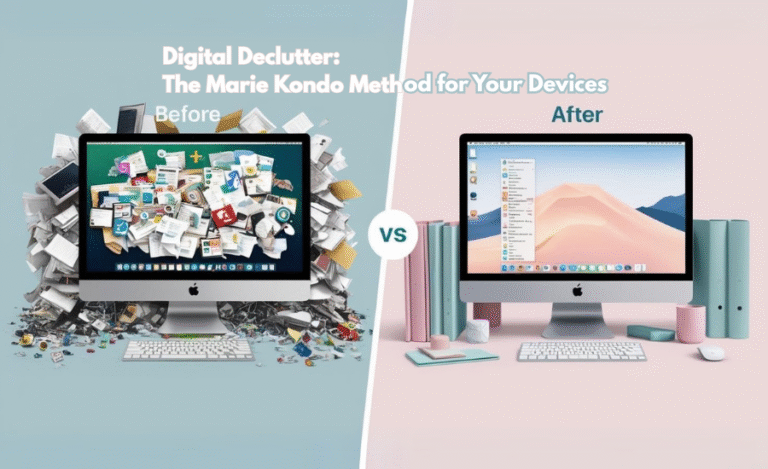
Do you ever end your day feeling drained, distracted, and like you’ve been pulled in a hundred different directions by the very devices meant to help you? You picked up your phone to answer one email and, an hour later, you find yourself deep in a rabbit hole of news feeds, notifications, and “urgent” requests, with your original goal completely forgotten. This feeling of being digitally hijacked isn’t a personal failing; it’s the result of a system designed to capture and monetize your attention. But what if technology could be redesigned not to distract, but to empower? This article explores the rise of mindful technology, a movement gaining unprecedented momentum in 2025. You will learn how innovative startups are moving us from an attention economy to an intention economy, creating tools that protect your focus, enhance your well-being, and give you back control of your time.
Beyond Digital Detox: What is Mindful Technology, Really?
For years, the solution to digital overload was presented as a “digital detox“—a temporary escape from the noise. But this is like holding your breath underwater; you eventually have to come up for air and face the same chaotic environment. Mindful technology offers a more sustainable solution. It’s not about abandoning technology, but about redesigning it from the ground up with human well-being as its core metric of success.
Imagine your digital life is a workshop. For many, it’s a cluttered, disorganized space. Tools are scattered everywhere, unfinished projects create tripping hazards, and the constant hum of machinery makes it impossible to think. This is the attention economy. A mindful technology approach is like a master craftsman redesigning that workshop. Every tool has a designated place. The workflow is logical and streamlined. Unnecessary noise is dampened, allowing for periods of deep, focused work. It’s a space designed for creation, not just reaction.
This approach, also known as “Humane Tech” or “Calm Technology,” is built on a few key principles:
- Empowering Intention: The technology helps you do what you set out to do, rather than luring you down unintended paths.
- Respecting Focus: It minimizes non-essential notifications and interruptions, protecting your most valuable cognitive resource.
- Operating in the Periphery: It provides information without demanding your full attention, much like a car’s fuel gauge is there when you need it but doesn’t constantly flash in your face.
- Promoting Ethical Persuasion: It avoids using psychological tricks like infinite scroll, variable rewards, and social validation loops that create compulsive behavior.
Essentially, mindful tech asks a revolutionary question: How can we make our devices work for our best interests, even when our impulses might not?
The Tipping Point: Why 2025 is the Breakout Year for Mindful Tech
While the conversation around digital wellness has been simmering for a decade, 2025 represents a critical inflection point. Several powerful currents have converged, transforming mindful technology from a niche ideal into a mainstream demand. We’ve moved past simply acknowledging the problem to actively seeking and building the solution.
First, the societal bill for the attention economy has come due. A 2024 study from the Global Wellness Institute highlighted that 65% of adults report feeling mentally exhausted by the end of the workday, with “constant digital connectivity” cited as a primary driver. Burnout is no longer just a workplace buzzword; it’s a public health crisis. This has created a massive, underserved market of consumers—from overwhelmed professionals to students struggling to focus on their studies—who are desperate for relief.
Second, the technological capabilities have finally caught up with the vision. Advances in contextual AI and on-device machine learning allow for a new breed of hyper-personalized, privacy-preserving tools. These aren’t just blunt instruments that block websites; they are intelligent agents that can understand your goals. For instance, an AI can learn that when your calendar says “Focus on Thesis,” it should mute social notifications but allow messages from your academic advisor. This level of nuance was science fiction five years ago; in 2025, it’s a key feature.
Tweetable Quote: “In 2025, we’re shifting from asking ‘What can I do with this technology?’ to ‘What is this technology doing to me?’ The answers are fueling the Mindful Tech revolution.”
Finally, a contrarian viewpoint is gaining economic traction: calmness is a competitive advantage. Companies are discovering that products that foster well-being inspire fierce brand loyalty. While an addictive app might drive high short-term engagement, a mindful service builds long-term trust and a healthier customer relationship, ultimately reducing churn and increasing lifetime value.
The Rise of Mindful Technology: Innovations from the Front Lines
So, who is building this new digital world? In 2025, the mindful technology landscape is blossoming with startups that are challenging the status quo. They aren’t just creating another meditation app; they are fundamentally rethinking the tools we use for work, communication, and connection.
AI-Powered Focus Assistants
This is perhaps the most active area of innovation. These tools go far beyond simple website blockers.
- Example: SereneOS. Imagine an operating system layer that actively shields you from distraction. SereneOS learns your work patterns and goals. If you’re writing a report, it might suggest putting your communication apps into an “asynchronous batch mode,” where notifications are held and delivered in a single bundle every 90 minutes. It uses AI to differentiate between a truly urgent request from your boss and a low-priority group chat update. This is pattern interrupt at its finest.
Emotionally-Aware Wearables and Apps
Leveraging biosensors in smartwatches and rings, a new generation of apps provides real-time feedback on your mental state.
- Example: Aura Ring 3. This (conceptual) evolution of existing wearable tech doesn’t just track your sleep and steps. It monitors subtle changes in heart rate variability (HRV), skin temperature, and electrodermal activity to detect rising stress levels. Instead of just presenting data, it intervenes. Your phone might gently buzz with a notification: “Your physiological stress levels are rising. Would you like to begin a 2-minute guided breathing exercise?” It’s a proactive coach, not a passive tracker.
Communication Platforms for Deep Work
The constant chatter of platforms like Slack and Teams is a major source of fractured attention. Mindful alternatives are emerging.
- Example: Flow-do. This project management tool redesigns communication from the ground up. Instead of an open-ended chat channel for every project, communication is tied directly to specific tasks. All conversations are threaded, and there’s a built-in “Focus Mode” that makes you unreachable for a set period, automatically updating your status with a clear “back online” time. It addresses the objection of “but what if I’m needed?” by creating clear, shared expectations around response times.
Investing in Serenity: The Business Case for Calm Tech
A common objection from skeptics is, “This all sounds nice, but how does it make money? The attention economy is worth trillions.” This perspective misses the bigger picture. Mindful technology isn’t a charity; it’s a powerful new value proposition in the $1.5 trillion global wellness market.
The business case rests on a few core pillars:
- Subscription over Surveillance: Most mindful tech startups operate on a clear subscription model. You pay for a service that serves you, not an advertiser. This transparency builds trust and a predictable revenue stream. Users are increasingly willing to pay for tools that protect their mental health, just as they pay for a gym membership.
- The High Cost of Churn: Addictive platforms have a churn problem. Users get burned out, delete the app, and feel resentful. Mindful platforms, by reducing stress and improving users’ lives, create “sticky” relationships based on genuine value, not psychological manipulation. The customer lifetime value (LTV) can be significantly higher.
- The “Wellness” Brand Halo: In 2025, a brand that is vocally pro-well-being gains a significant competitive edge. It attracts talent that wants to build meaningful products and customers who are making more conscious purchasing decisions. It’s a brand differentiator in a crowded market.
- Corporate and Educational Adoption: The biggest opportunity may lie in B2B and B2E (Business to Education). Companies and universities are hemorrhaging money due to productivity loss from burnout and distraction. They are now actively investing in mindful technology platforms for their employees and students to improve focus, creativity, and mental health outcomes.
How to Integrate Mindful Technology: A Practical Framework
Feeling inspired but unsure where to start? You don’t need to wait for the perfect suite of tools. You can begin applying the principles of mindful technology today. Here is a practical framework to audit and redesign your own digital life.
This “Mindful Tech Audit” can help you shift from a reactive to an intentional relationship with your devices.
The Mindful Tech Audit Checklist
- Step 1: The Notification Inventory (The Cull)
- For one day, let your notifications build up without clearing them.
- At the end of the day, review every single one. For each app, ask: “Did this notification genuinely serve my goals, or did it serve the app’s goal of pulling me in?”
- Ruthlessly turn off all non-essential notifications. Keep only those from real people that are time-sensitive (e.g., phone calls, calendar alerts).
- Step 2: Home Screen Curation (The Workshop)
- Remove all social media, news, and entertainment apps from your phone’s home screen. Move them into a folder on the second or third page. This adds a crucial moment of friction, forcing you to ask, “Do I really want to open this?”
- Reserve your home screen for “tools,” not “traps.” These are apps with a specific function that you open, use, and close (e.g., camera, maps, notes, calendar).
- Step 3: Define Your Digital Blocks (The Schedule)
- Deep Work Blocks: Schedule 1-2 blocks of 90 minutes each day where you do nothing but your most important task. Use a focus app (like Forest or Freedom) to block distracting sites during this time.
- Shallow Work Blocks: Designate specific times to check email and messages. Batch these tasks instead of letting them interrupt you all day.
- Digital Sunset: Set a “tech curfew” 30-60 minutes before bed. Put your phone away and allow your mind to wind down naturally.
- Step 4: Curate Your Consumption (The Diet)
- Unsubscribe and unfollow aggressively. If a newsletter, podcast, or social media account consistently makes you feel anxious, angry, or inadequate, remove it.
- Replace passive scrolling with active, intentional consumption. Instead of Browse Instagram, use that time to read one long-form article you saved or watch one educational video.
By performing this audit, you are not just cleaning up your phone; you are reclaiming your cognitive sovereignty.
Conclusion: From Attention to Intention
The rise of mindful technology in 2025 is more than a trend; it’s a necessary course correction. For too long, we have allowed our digital tools to set the agenda, leaving us feeling overwhelmed and out of control. We’ve accepted a false trade-off: that to be connected and productive, we must also be constantly distracted and available.
The innovators and startups at the forefront of this movement are proving that another way is possible. They are building a future where technology respects our boundaries, protects our focus, and supports our well-being. By shifting the goal from capturing attention to empowering intention, they are not only creating better products but fostering a healthier human experience.
The journey is far from over, but the path forward is clear. The future of technology isn’t about more speed, more features, or more connectivity. It’s about more mindfulness. It’s about time we demanded that our tools help us live the lives we actually want to live.
What is one small change you can make today to make your technology more mindful? Share your commitment in the comments below!
Frequently Asked Questions
- Isn’t “mindful technology” just another name for screen time apps?
While managing screen time is a component, mindful technology is a much broader concept. It’s less about the quantity of time spent and more about the quality of that time. Rather than simply blocking access, it focuses on fundamentally redesigning the user experience to be less intrusive, less persuasive, and more aligned with the user’s long-term goals. It’s about changing the core mechanics of an app, not just putting a timer on it. - How can I find startups and apps that are building mindful technology?
A great place to start is by looking at organizations like the Center for Humane Technology, which often highlights products that align with their principles. You can also search for terms like “calm tech,” “humane design,” and “ethical tech.” Look for apps with clear, subscription-based business models, as this often indicates their loyalty is to you, the user, rather than to advertisers. Finally, read the “philosophy” or “about us” page of a software company—mindful companies are often very vocal about their user-centric mission. - Is mindful technology anti-social media?
It’s not anti-social media, but it is critical of the current design of most major social media platforms. Mindful technology principles would advocate for social platforms without features like infinite scroll, autoplay videos, and vanity metrics (like public like counts) that are known to foster anxiety and compulsive use. A mindful social network might prioritize smaller group interactions, chronological feeds, and give users far more control over what they see and when they see it. - What’s the difference between mindful technology and digital minimalism?
Digital minimalism is a personal philosophy focused on radically reducing the amount of technology in one’s life to only what is essential. Mindful technology is a design philosophy for building technology. The two are highly compatible. A digital minimalist would likely choose to use products built with mindful technology principles, as these tools would align with their goal of using tech in a very intentional and non-intrusive way. One is a user philosophy; the other is a creator philosophy.






